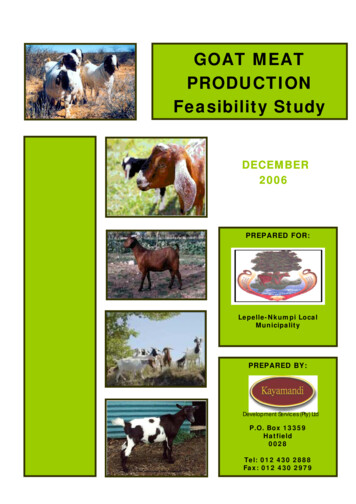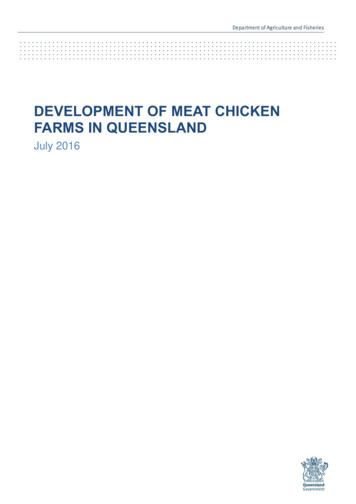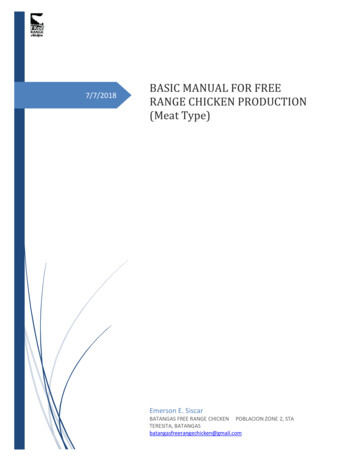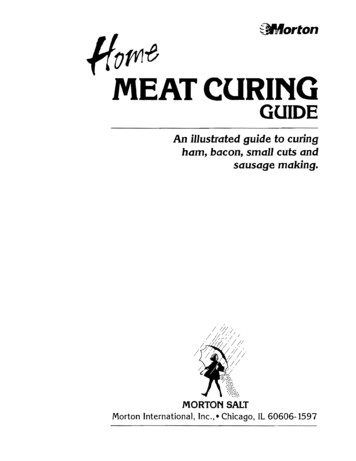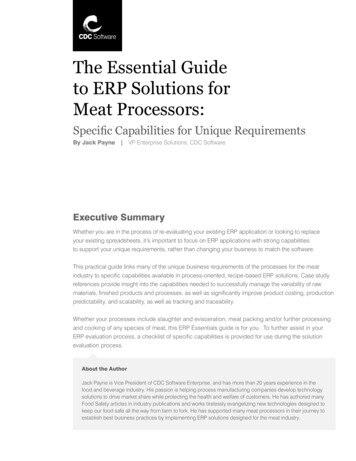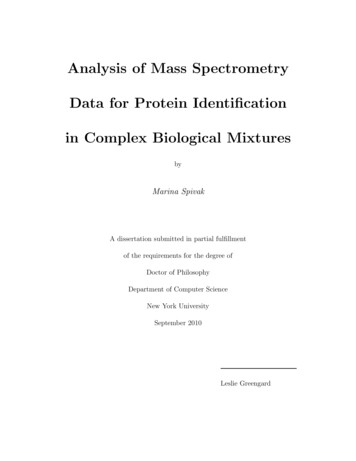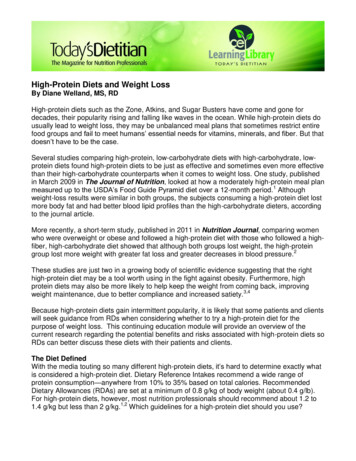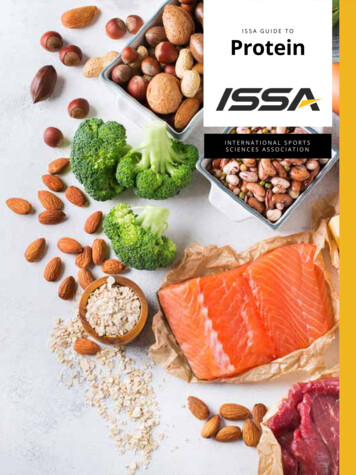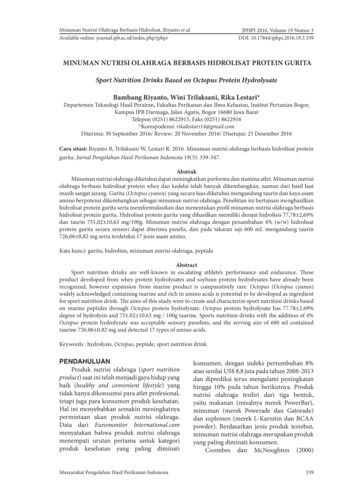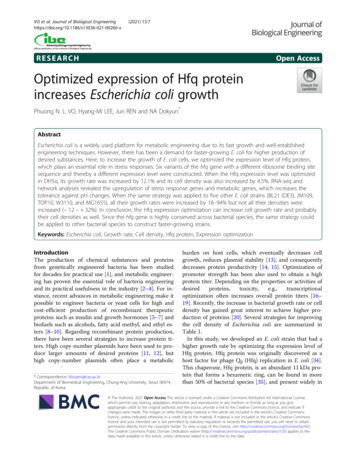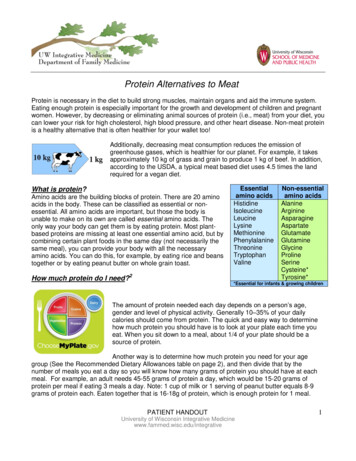
Transcription
Protein Alternatives to MeatProtein is necessary in the diet to build strong muscles, maintain organs and aid the immune system.Eating enough protein is especially important for the growth and development of children and pregnantwomen. However, by decreasing or eliminating animal sources of protein (i.e., meat) from your diet, youcan lower your risk for high cholesterol, high blood pressure, and other heart disease. Non-meat proteinis a healthy alternative that is often healthier for your wallet too!Additionally, decreasing meat consumption reduces the emission ofgreenhouse gases, which is healthier for our planet. For example, it takesapproximately 10 kg of grass and grain to produce 1 kg of beef. In addition,according to the USDA, a typical meat based diet uses 4.5 times the landrequired for a vegan diet.What is protein?Amino acids are the building blocks of protein. There are 20 aminoacids in the body. These can be classified as essential or nonessential. All amino acids are important, but those the body isunable to make on its own are called essential amino acids. Theonly way your body can get them is by eating protein. Most plantbased proteins are missing at least one essential amino acid, but bycombining certain plant foods in the same day (not necessarily thesame meal), you can provide your body with all the necessaryamino acids. You can do this, for example, by eating rice and beanstogether or by eating peanut butter on whole grain toast.How much protein do I need?2Essentialamino ino ntial for infants & growing childrenThe amount of protein needed each day depends on a person’s age,gender and level of physical activity. Generally 10–35% of your dailycalories should come from protein. The quick and easy way to determinehow much protein you should have is to look at your plate each time youeat. When you sit down to a meal, about 1/4 of your plate should be asource of protein.Another way is to determine how much protein you need for your agegroup (See the Recommended Dietary Allowances table on page 2), and then divide that by thenumber of meals you eat a day so you will know how many grams of protein you should have at eachmeal. For example, an adult needs 45-55 grams of protein a day, which would be 15-20 grams ofprotein per meal if eating 3 meals a day. Note: 1 cup of milk or 1 serving of peanut butter equals 8-9grams of protein each. Eaten together that is 16-18g of protein, which is enough protein for 1 meal.PATIENT HANDOUTUniversity of Wisconsin Integrative Medicinewww.fammed.wisc.edu/integrative1
Protein Alternatives to MeatRecommended Dietary Allowancefor Protein*AgeGrams of proteinneeded each dayChildren ages 1 – 313Children ages 4 – 819Children ages 9 – 1334Girls ages 14 – 1846Boys ages 14 – 1852Women ages 19 – 70 46Men ages 19 – 70 56*This is for people who get less than 30 minutes of physical activity a day on top of their regular daily activities. Peoplewho are more active should increase their protein while staying within their recommended needed calories.What are some good sources of non-meat protein?A variety of good sources of non-meat protein are listed below. Please see the chart on page 6for information on serving size and whether the protein is vegan or gluten-free.Quinoa and Other Whole GrainsWhole grains are an important source of protein. The best is quinoa (pronounced KEENwah or kee-NOH-uh), which is originally from South America. It contains all nine essentialamino acids. Hence it is considered a ―complete protein‖ just like meat. Although quinoa istechnically a seed, it is usually regarded as a grain and can be found next to other grainsin your local grocery store or co-op. Other good whole grains are brown rice, barley,buckwheat and whole wheat. These grains lack the amino acid lysine and are besteaten with nuts or legumes (for example--beans, lentils, peanuts, peas).Eating Tips: Quinoa is simple and quick to make. Just add one cup of quinoa to 1 cup ofwater. Bring the water to a boil. Then reduce it to a simmer until the outer rings on thequinoa grains begin to separate and look like a halo (10-15 minutes). If the water boils offbefore the quinoa is ready, add a little more water. Add any sauce, oil, seasonings, orvegetables to suit your taste!Nuts, Seeds and Nut ButterAlmonds, walnuts, cashews, pine nuts, and peanuts (which are classified as a legume)are all good protein sources for vegetarians, as are sesame and sunflower seeds.Unfortunately, they are also high in fat, so they should not be the main source of protein.Walnuts are a good source of omega-3 fatty acids. And some nut butters now containadded vegetarian-friendly omega-3s. (Omega-3’s are healthy fats that can help reduceinflammation in the body. For more information, see our handout Omega-3 Fats.)Eating Tips: Raw, toasted or in a butter/spreadable form, nuts and seeds are a greatprotein source. Try adding them to your morning oatmeal or salads. Avoid ones that areheavily salted; instead reach for the unsalted or lightly salted ones.PATIENT HANDOUTUniversity of Wisconsin Integrative Medicinewww.fammed.wisc.edu/integrative2
Protein Alternatives to MeatLegumes (aka Pulses)Kidney, garbanzo/chickpeas, white, black, pinto, edamame (green soybeans), and lentilsare just a few of various beans available. These beans are easily digested and have twiceas much protein as wheat and three times more than rice. But they are missing the aminoacid methionine and are best eaten with a whole grain.Eating Tips: Soak dry beans a day or two before you want to cook them. If you buycanned beans, rinse with water and drain them to remove some of the sodium addedduring canning. You can use frozen beans to save time and avoid extra sodium. Snack onhummus made from garbanzo beans or edamame with veggies and pita bread.Tofu, Tempeh and Other Soy ProductsSoy is a bean, but because of its popularity and great health value, we are listing itseparately from other beans. Tofu, tempeh (fermented soybeans) and other organic soyproducts are excellent low-fat sources of protein. Although tempeh has a mild nutty flavor,tofu is relatively flavorless. You can find milk, yogurt, cheese, and ice cream all made fromsoy. So go ahead, eat your heart out.Eating Tips: Try adding tofu or tempeh to your next stir-fry. Crumble it in stews, soups,and pasta dishes, or lightly blend it and cook it up like scrambled eggs. Enjoy it with a nicecold glass of soy milk.Imitation/Faux MeatVeggie burgers, seitan (aka mock duck, which comes from wheat), faux chicken pattiesand other fake meat products were once limited to specialty stores but are now morewidely available. They are typically made from soy, wheat gluten protein, or a combinationof the two. These items tend to have more fiber and less fat than the real thing. Be sure toread the package if you have gluten sensitivity and choose items made from non-wheatprotein. Also check the amount of sodium per serving and limit portions appropriately.Eating Tips: You can grill black bean burgers, make that faux turkey sandwich you havebeen craving, brown soy-based “ground beef” for tacos, chili or your favorite pasta dish.Dairy and EggsDairy products and eggs are wonderful sources of complete protein. Dairy productsinclude milk, cheese, yogurt, and ice cream. These can be high in fat, especially saturatedfat, so be sure to choose low-fat items or limit your number of servings. Eggs are great forprotein, but also contain a fair amount of cholesterol from their yolks, so either limit yourweekly egg intake or stick to egg whites. Choose free-range eggs and milk from grass-fedcows if possible because they have more omega 3’s.Eating Tips: Adding one glass of milk to each meal provides half of the protein needed ina healthy diet. Yogurt alone, with fruit, cereal or added to smoothies is perfect for thosesweet cravings. Eggs scrambled, poached, in an omelet or a stir-fry makes a nice additionto any meal.PATIENT HANDOUTUniversity of Wisconsin Integrative Medicinewww.fammed.wisc.edu/integrative3
Protein Alternatives to MeatGreek YogurtGreek yogurt is an excellent source of healthy protein. The straining process removesmuch of the liquid whey, lactose and sugar, giving it a richer and creamier consistency. Itis higher in protein and lower in sodium and carbohydrates than other yogurts. TraditionalGreek yogurt has more fat than regular yogurt, but nonfat, 1% and 2% milkfat varieties areavailable. Yogurt also has the benefit of providing probiotics (good bacteria) that keep thegut healthy. Greek style yogurt is now available in most locations where yogurt is sold. Atthis time there is no information to suggest that one brand is better than another.Eating Tips: You can add Greek yogurt to fruit or cereal, enjoy as a topping for chili, stewsand soups, try it with walnuts and honey for dessert, or even use it as a healthy, proteinpacked replacement for sour cream or cream cheese in recipes.Recipes - Enjoy!Greek Yogurt1 cup of nonfat or lowfat plain Greek yogurt (available at most grocery stores)1-2 teaspoons of honey1 small handful of frozen or fresh berries of your choice (e.g., blueberries)Red Quinoa and Avocado Salad(Recipe provided by www.Allrecipes.com; submitted by Gitano)Ingredients1/3 cup red quinoa2/3 cup water1 cup cherry tomatoes, halved½ cup diced cucumber¼ cup diced red onion2 tablespoons lime juice½ teaspoon ground cumin seedSalt and pepper to taste2 cups baby spinach leaves1 avocado—peeled, pitted and sliced1. Bring the quinoa and water to a boil in a saucepan over high heat. Reduce heat tomedium-low, cover, and simmer until the quinoa is tender, and the water has beenabsorbed, about 15-20 minutes. Spread into a mixing bowl, and refrigerate until cold.2. Once the quinoa has chilled, gently stir in the tomatoes, cucumber, and onion. Seasonwith lime juice, cumin, salt, and pepper; stir to combine. Divide the spinach leaves ontosalad plates, and top with the quinoa salad. Garnish with the avocado slices. 2 servings.Approximate nutrition information per serving: Protein: 8.1g, Total Fat: 17.3g, Cholesterol:0mg, Carbohydrates: 37.1g (fiber: 11.5g), Sodium: 240 mg, Calories: 311.PATIENT HANDOUTUniversity of Wisconsin Integrative Medicinewww.fammed.wisc.edu/integrative4
Protein Alternatives to MeatMock Tuna Salad(Recipe provided by www.Allrecipes.com; submitted by NICE GIRL 1965)Ingredients1 (19 oz) can garbanzo beans (chickpeas), drained and mashed2 tablespoons mayonnaise2 teaspoons spicy brown mustard1 tablespoon sweet pickle relish2 green onions, choppedsalt and pepper to tasteIn a medium bowl, combine garbanzo beans, mayonnaise, mustard, relish, chopped greenonions, salt and pepper. Mix well. Serve in a salad or on crackers or toast. 4 servings.Approximate nutrition information per serving: Protein: 7g, Total Fat: 7.2g, Cholesterol: 3mg,Carbohydrates: 32.7g (fiber: 6.2g), Sodium: 507mg, Calories: 220.[Clinician note: For an even healthier alternative, omit the pickle relish to reduce sodium anduse light mayo or vegan mayo to reduce the amount of fat.]Barley Bake(Recipe provided by www.Allrecipes.com; submitted by KATINHAT)Ingredients¼ cup butter1 medium onion, diced1 cup uncooked pearl barley½ cup pine nuts2 green onions, thinly sliced½ cup sliced fresh mushrooms½ cup chopped fresh parsley¼ teaspoon salt and 1/8 teaspoon pepper2 (14.5 ounce) cans vegetable broth1. Preheat oven to 350 degrees F (175 degrees C).2. Melt butter in a skillet over medium-high heat. Stir in onion, barley, and pine nuts. Cookand stir until barley is lightly browned. Mix in green onions, mushrooms, and parsley.Season with salt and pepper. Transfer mixture to a 2 quart casserole dish. Stir in thevegetable broth.3. Bake 1 hour and 15 minutes in the preheated oven or until liquid has been absorbed andbarley is tender. 6 servings.Approximate nutrition information per serving: Protein: 7.4g, Total Fat: 14.2g, Cholesterol:20mg, Carbohydrates: 33.2g (fiber: 7g), Sodium: 437mg, Calories: 280.[Clinician note: For an even healthier alternative, use olive oil in place of butter, decreasesalt, and/or use low sodium vegetable broth.]PATIENT HANDOUTUniversity of Wisconsin Integrative Medicinewww.fammed.wisc.edu/integrative5
Protein Alternatives to MeatAMOUNT OF PROTEIN IN A Brown Rice,medium grn(cooked)Quinoa(cooked)Buckwheat(cooked)Whole wheatbreadWalnuts,English (raw)PeanutButter,smoothAlmondButter1/2 cWoman’scuppedpalmWoman’spalmWoman’spalm1 slice2.3 g0.8 g4g1.8 g2.8 g0.5 g2.7 g0.9 g14 halves4.4 g19 g8g16 g6.7 g1/2 c1/2 c25 g¼ c or1 oz2 TbspCarbohydrates(Fiber)23 g(2 g)Calories(kcal)VeganGlutenFree109YesYes20 g(2.6 g)17 g(2.3 g)12 g(1g)4g(2 g)6g(2 .8g6g(3.3 g)196YesYes9g0.4 g115YesYes7.7 g0.4 g20 g(7.8 g)20 g(5.7g)112YesYes7.6 g0.5 g114YesYes2.4 g2.9 g20 g(7.5 g)4g(2 g)40-50YesYes18 g9.4 g196YesYes5.8 g11.3g2.3 g52YesYes11 g4.4 g124YesNo78NoYesTempeh(cooked)Tofu (firm)100 gVeggieBurgerEgg:hardboiledMilk 1%:low fatYogurtNonfatGreekYogurtNonfat70 g1 wholewalnutshell1 man’spalm1 wholewalnutshellDeck ofcardsDeck ofcards1 patty50 g1 large egg6.3 g5.3 g2g(0.1 g)10 g(3.4 g)0.6 g8 oz1 glass8.2 g2.3 g12 g102NoYes8oz/1 cup8oz/1 cup1 individualcontainer1 esLentils(cooked)Kidneybeans(cooked)Black beansHummus(chickpeas)2 Tbsp½c½ c or4 oz½ c or4 oz2 Tbsp84 g* c cup; g gram; oz ounce; Tbsp tablespoonPATIENT HANDOUTUniversity of Wisconsin Integrative Medicinewww.fammed.wisc.edu/integrative6
Protein Alternatives to MeatReferences1. Agricultural Research Service. Dec. 12, 2010 (last update). Search the USDA National NutrientDatabase for Standard Reference. U.S.D.A. www.nal.usda.gov/fnic/foodcomp/search/2. CDC. Feb. 23, 2011 (last update). Nutrition for Everyone: Protein. 3. Center for Nutrition Policy and Promotion. Mar. 2002. How much are you eating? Dietary guidelinesfor Americans. U.S.D.A. www.cnpp.usda.gov/Publications/DietaryGuidelines/ 2000/2000DGBrochureHowMuch.pdfThe information in this handout is for general education. Please work with your healthcare practitioner to use this information in the best way possible to promote yourhealth.This handout was created by Rebecca McSorley M4, Luke Fortney MD, Asst. Professor, andCharlene Luchterhand MSSW. All three are in the Integrative Medicine Program, Dept. of FamilyMedicine, University of Wisconsin-Madison School of Medicine and Public Health.Date Created: October 2011Notes:PATIENT HANDOUTUniversity of Wisconsin Integrative Medicinewww.fammed.wisc.edu/integrative7
only way your body can get them is by eating protein. Most plant-based proteins are missing at least one essential amino acid, but by combining certain plant foods in the same day (not necessarily the same meal), you can provide your body with all the necessary amino acid
